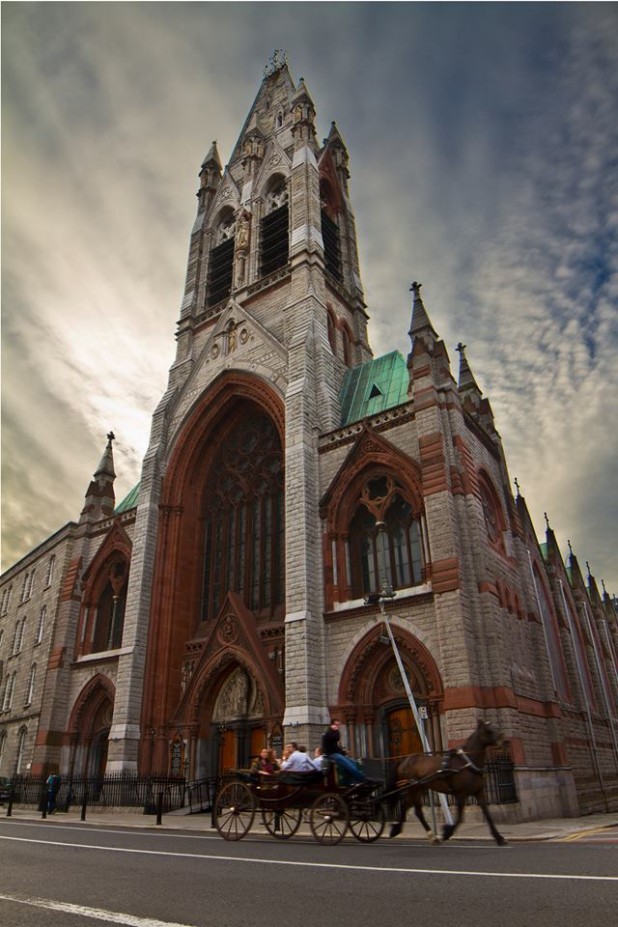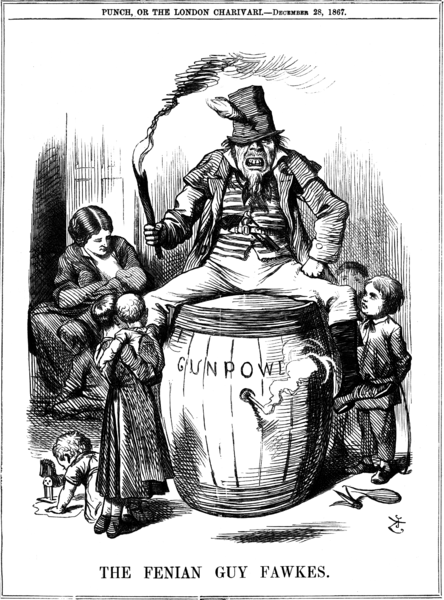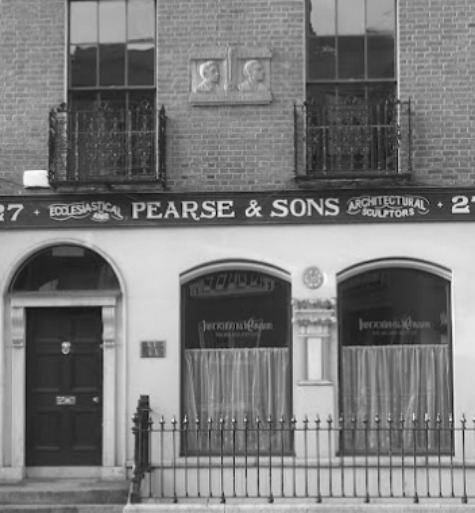
This image by Paul Reynolds captures the beautiful John’s Lane Church in the heart of the Liberties, which has long interested me because of its hidden history.
PLEASE NOTE: This article was originally published on ComeHereToMe.com. We have republished it under a Creative Commons Attribution-NonCommercial-NoDerivs 3.0 Unported license (CC BY-NC-ND 3.0).
The Thomas Street church first opened in 1874 (after work began in 1862), with Edward Welby Pugin the architect behind the project. Pugin came from an incredibly distinguished architectural family, the son of Augustus Pugin, who carried out the interior design of the Palace of Westminster, as well as being responsible for many religious buildings in Ireland and Britain.
My interest in John’s Lane Church comes not from the architectural history of the building, but rather a nickname the church has acquired in its own community, spoken of as the ‘Fenian Church’. This nickname comes from the fact many Fenians worked at the building site, such as the Pagan O’Leary, Denis Cromien, Dan Gleason, Michael Lawless and Michael Malone. Ironically however, so too did a man named Pierce Nagle, a comrade in their eyes but a secret informer who would send them to penal servitude.
The Fenian Brotherhood in Ireland had been founded in Dublin by James Stephens and others on Saint Patrick’s Day in 1858. Stephens was a veteran republican who had spent time in exile in Paris as a result of his revolutionary activity. It was to be a secret revolutionary organisation, established thanks to American financial backing, which would advocate armed revolution to establish Irish independence. The Fenians were a real threat to the establishment, mounting bombing campaigns in Britain for example which targeted military infrastructure, government and public transport among other targets.

A Punch cartoon from 1867 depicting a ‘Fenian Guy Fawkes’
The centenary booklet of the church issued by the church in 1962 noted that:
While their hearts were busy with trowel and shovel their hearts were busy with revolution. By day they were the busy builders of John’s Lane, by night they talked of arms and Man and drilled in halls and fields. They were the Fenian Men. Denis Cromien, foreman of foremen, was there and had sworn a thousand men of the building trade into his circle.
Patrick O’Leary who worked on the site, known as the Pagan O’Leary, is a fascinating character in the history of Irish republicanism. Originally from County Cork, O’Leary spent some time in America, studying for a priesthood in the Catholic Church and even fighting in the Mexican War. Active within the Fenian Brotherhood having settled in New York, he would develop intense anti-Catholic views, and as Bridget Hourican has noted “he hated England and the Roman Catholic church with equal intensity, arguing that after driving out the English, Ireland should revert to the old paganism of Fionn mac Cumhaill”. As a result of these views, the name Pagan O’Leary was bestowed upon him by contemporaries.
While many of the stonemasons working on the church had taken the Fenian Oath, their betrayal came in 1865 thanks to the testimony of Pierce Nagle, a Tipperary native who had won the confidence and trust of those around him within the republican movement and at the John’s Lane site. He had first offered his service to the British authorities in 1864 while in America, and Nagle’s position within the movement kept the authorities aware of plans for insurrection and revolt in 1865. Many of the men who worked on John’s Lane Church would be sentenced to terms of penal servitude on the back of Nagle.
The church also boasts a strong connection to James Pearse, the father of Patrick and William Pearse. The English-born Pearse was a mason and monumental sculptor, who operated out of a premises on Great Brunswick Street. This street is today known as Pearse Street, and the family shop front has been beautifully restored with a plaque to the Pearse brothers also upon it.

27 Pearse Street today
The twelve statues in the niches on the church tower are the work of Pearse. Pearse was a very capable sculptor, and had won an award at the 1882 Dublin Exhibition for example for his High Altar for the Rotunda. The name ‘Pearse and Sons’ was adopted by the company he had established at the time of his death, and The Ireland Institute (who maintain the premises today) note:
On his death, Willie and Patrick Pearse took over the running of the business. Willie was nineteen and studying at the Metropolitan School of Art and was later to travel to London and Paris for further training. Patrick was at this stage using the title ‘Patrick H. Pearse, Sculptor’ and the company’s name had become ‘Pearse and Sons.’
Following the closure of the family business, the premises became home to the South City Workingmen’s Temperance Club, later a car company and many other ventures. It was acquired by its present owners in 1996, and has hosted many cultural and political events. Its facade, and the figures upon the ‘Fenian Church’ on Thomas Street, are reminders of the talented James Pearse.
PLEASE NOTE: This article was originally published on ComeHereToMe.com. We have republished it under a Creative Commons Attribution-NonCommercial-NoDerivs 3.0 Unported license (CC BY-NC-ND 3.0).








